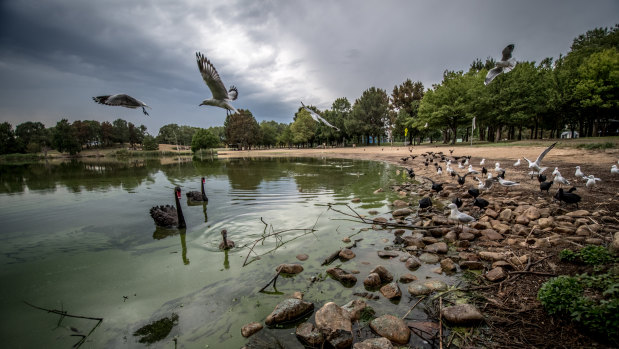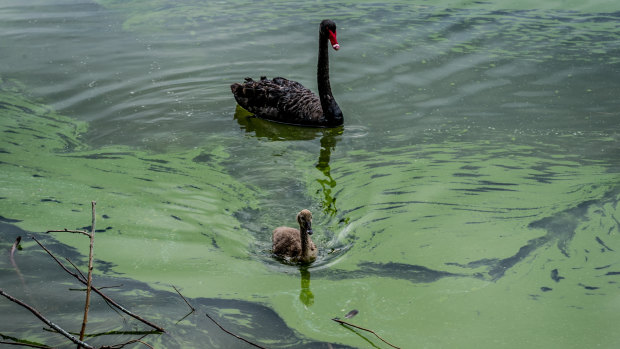The ACT government will look at new technologies to fix the territory's worsening blue-green algae problem when funding for the existing treatment program dries up in June, it says.
The $93 million ACT Healthy Waterways program has seen new ponds, rain gardens, and wetlands sprout up across the national capital, with the intention to have fully-fledged natural filtration systems by about 2021.

Birds swim and eat in the blue-green algae-contaminated waters of Lake Tuggeranong.Credit: Karleen Minney
But the government was reliant on university research and extra funding to stop the plan from going stagnant.
"ACT Healthy Waterways wraps up in June. The lakes aren't going to be fixed by then, so the government will consider options through the budget process and we've relied on Commonwealth funding [for the program] as well," the ACT's director of water catchment and policy, Matt Kendall, said.
"[The University of Canberra] are doing some research trials in Lake Tuggeranong looking at different additives that you can apply to the water that may be able to suppress the blue-green algae.
"We're hopeful they might turn up some options."
Lake Tuggeranong is among the territory's worst affected by blue-green algae blooms, having been closed entirely to primary contact activities - such as swimming and bathing - since December last year.
Blue-green algae is capable of producing very potent neurotoxins, which are destructive to nerve tissue, and toxins that induce liver damage. Lake Tuggeranong is still open to secondary contact activities, like rowing and boating.
"Water management authorities will certainly be determining if the bloom in Lake Tuggeranong is toxic but the best approach is to assume toxicity until the true nature is known," Australian National University researcher, Dr Ben Long, said.
The area of the lake near Tuggeranong town park has recorded bacteria in the water as well as blue-green algae. The bacteria that is tested for, enterococci, are normally found in humans' gastrointestinal tracts.

Researchers are still working to determine whether the blue-green algae contains toxins that could be extremely harmful to humans.Credit: Karleen Minney
"[Blue-green algae] be harmful to dogs in particular so one of the messages is to keep your pets away from the water - don't let your dogs go in it. Native wildlife are often adapted to it, so birds [and the like]," Mr Kendall said.
Bacteria in the water could be because of sewage overflows or bacteria in stormwater drains.
The persistently high blue-green algae levels in Lake Tuggeranong could also lead to a lack of oxygen in the water, resulting in fish kills. But that doesn't appear to have happened as yet, Mr Kendall said.
The bloom in Lake Tuggeranong had large accumulations of algae on the shoreline, which sometimes resemble mats of green paint, and masses in the water appeared to get worse over the weekend.
"This is perhaps the most dense bloom I’ve seen in Lake Tuggeranong in the past decade," Dr Long said.
Strong winds could potentially break down the blue-green algae and disperse it but cooler temperatures would see the lake's warmer top merge with its cooler, more protected bottom, where fish are helped by nutrients.
"We're hopeful work will continue towards other activities [to help the lake following June]," Mr Kendall said.